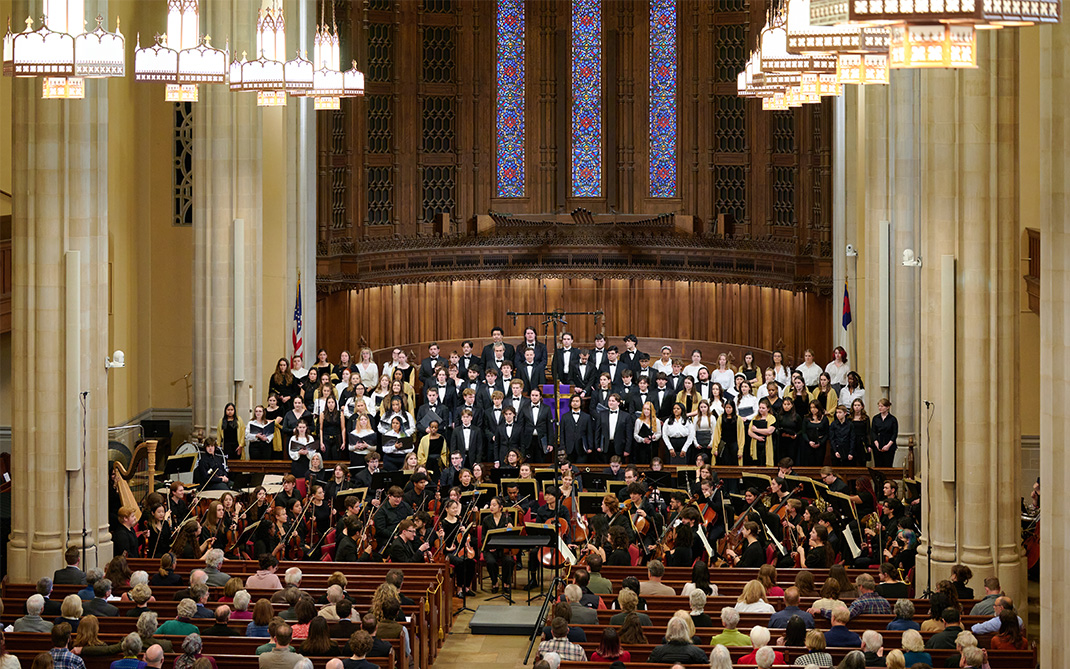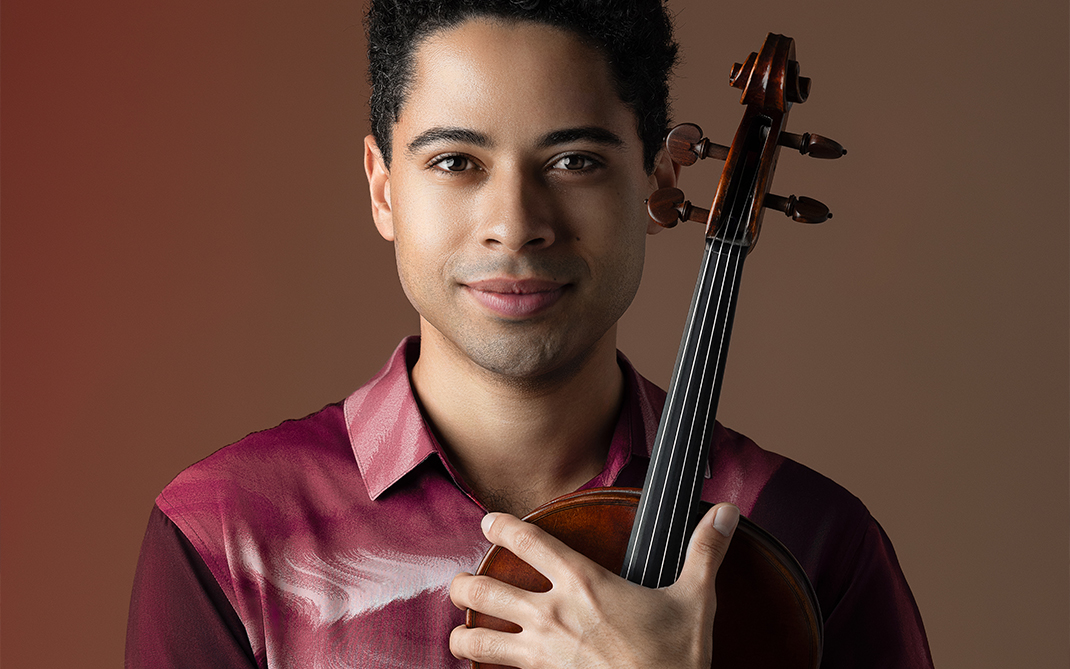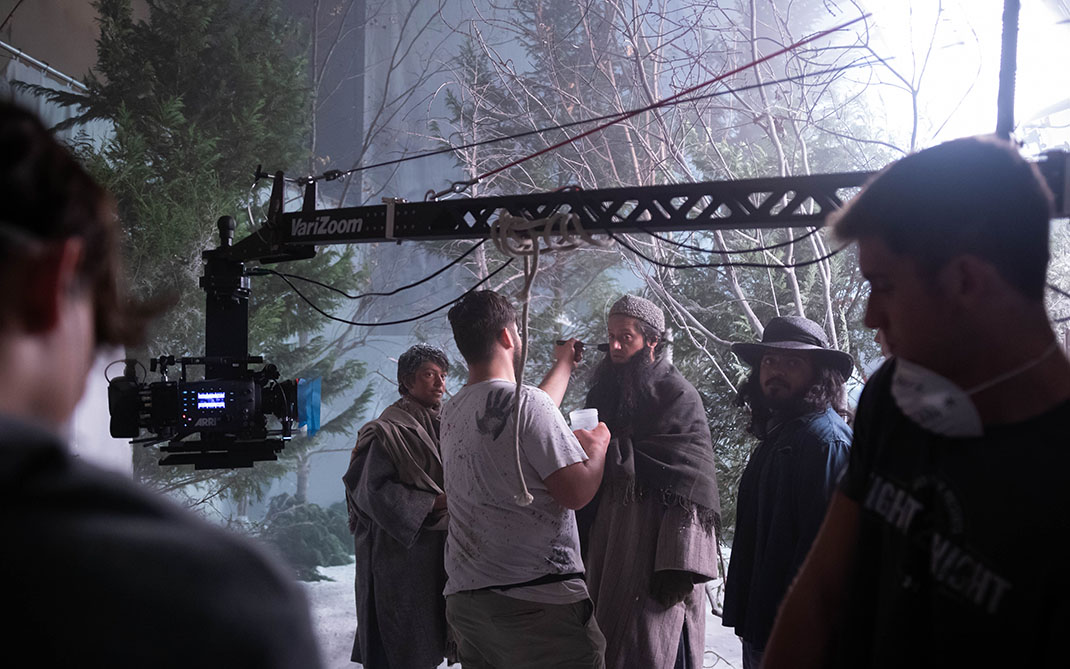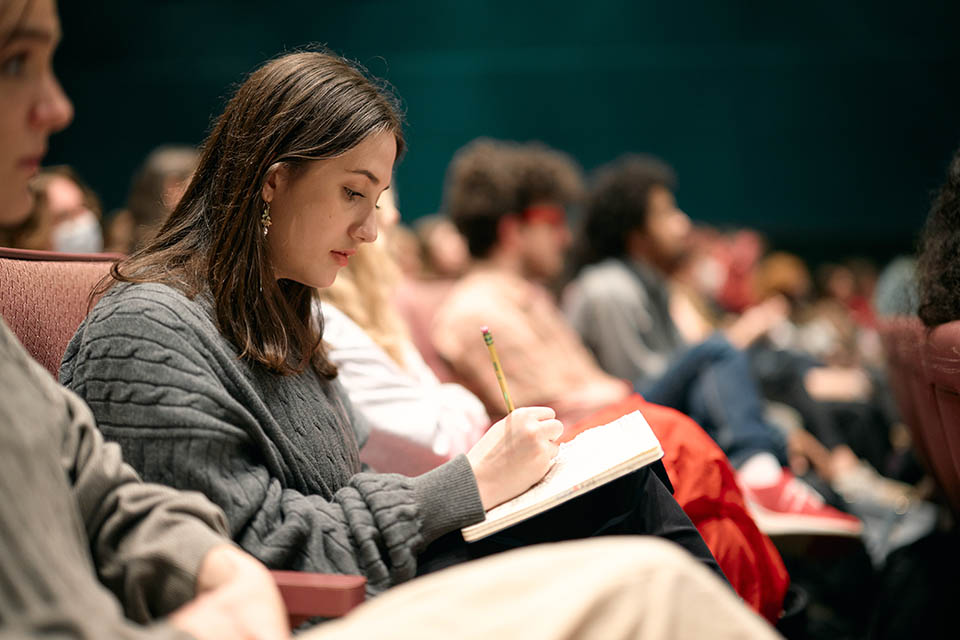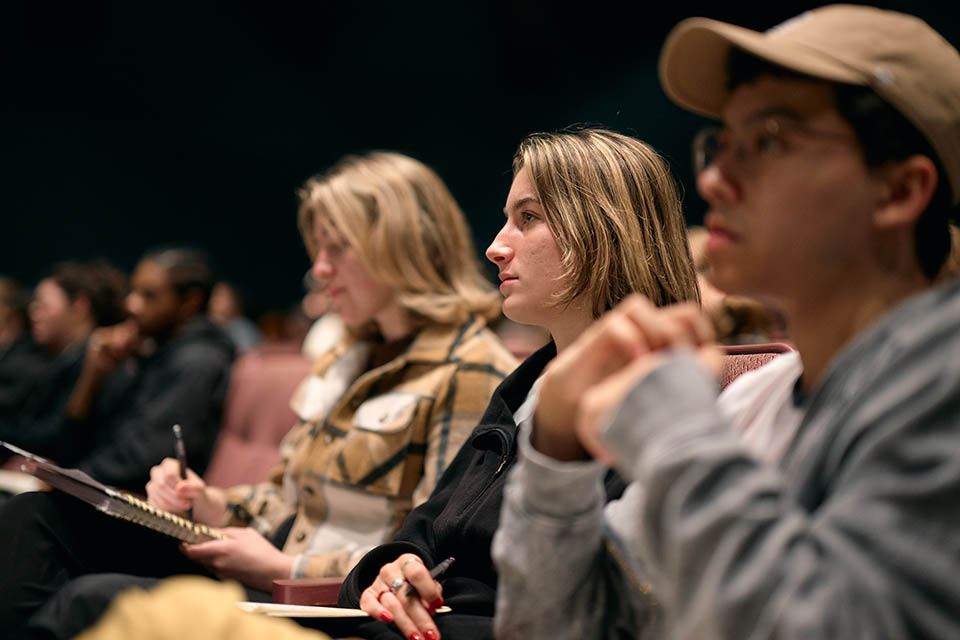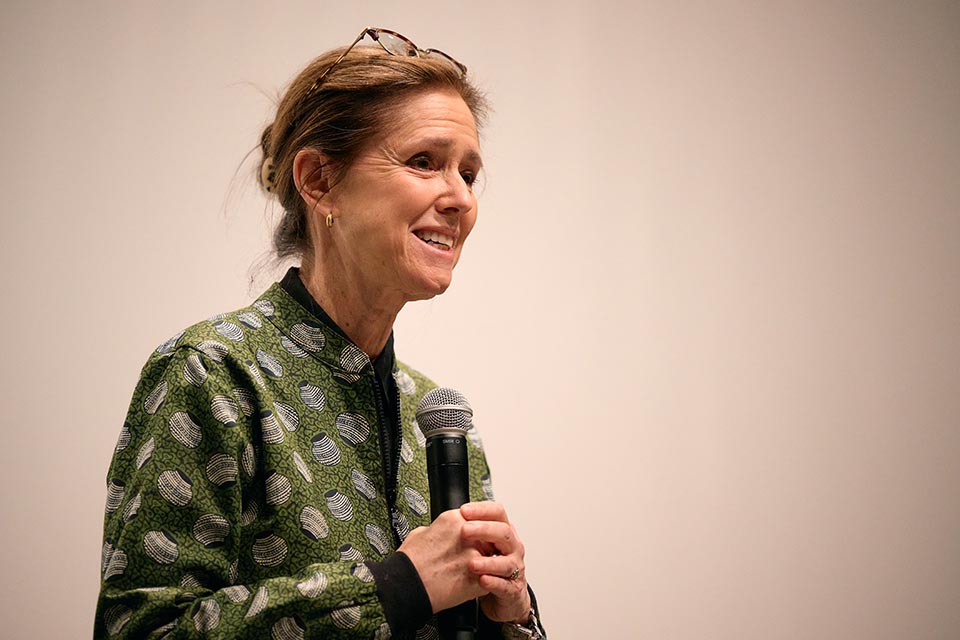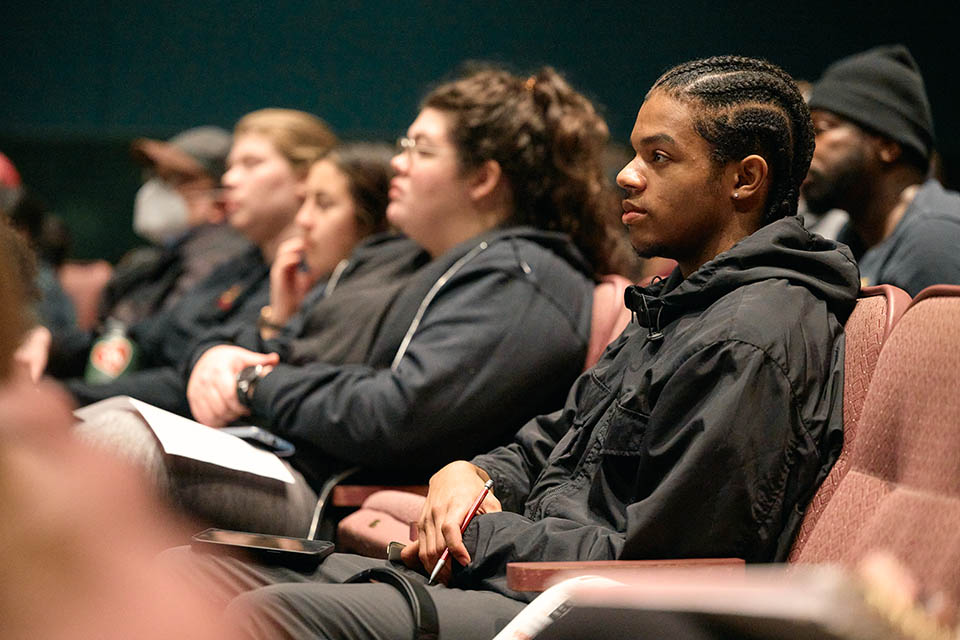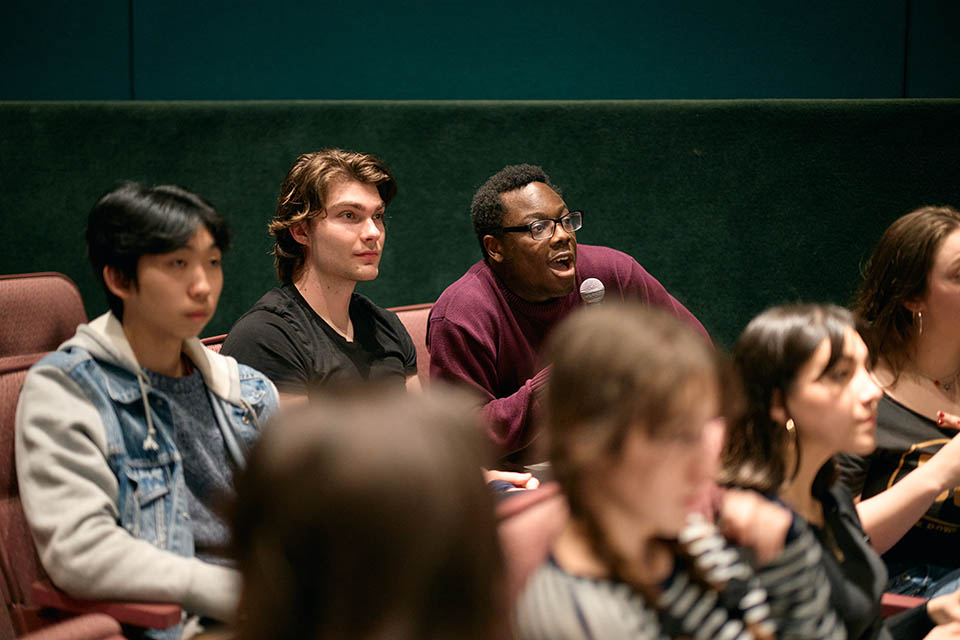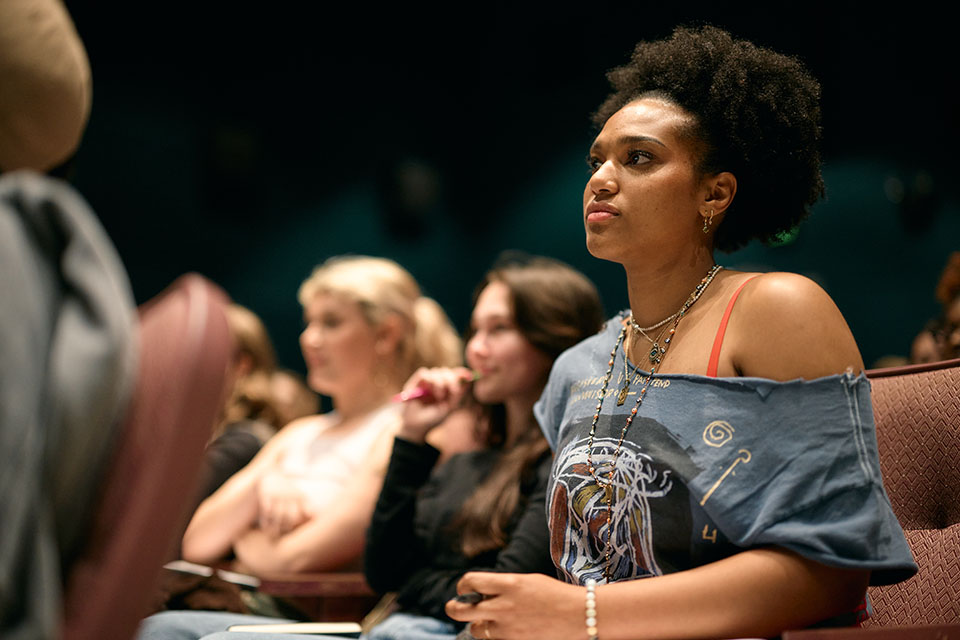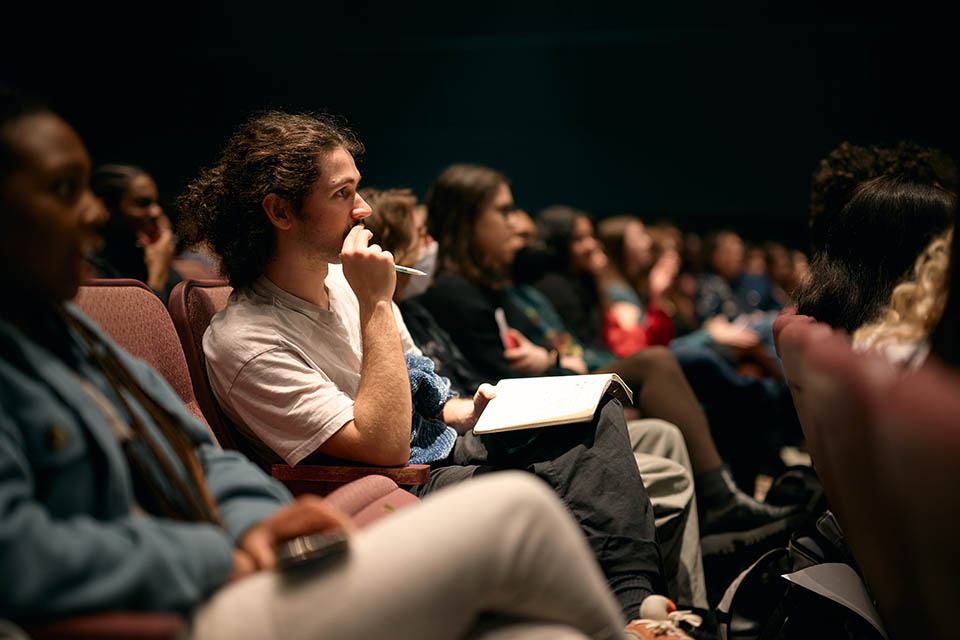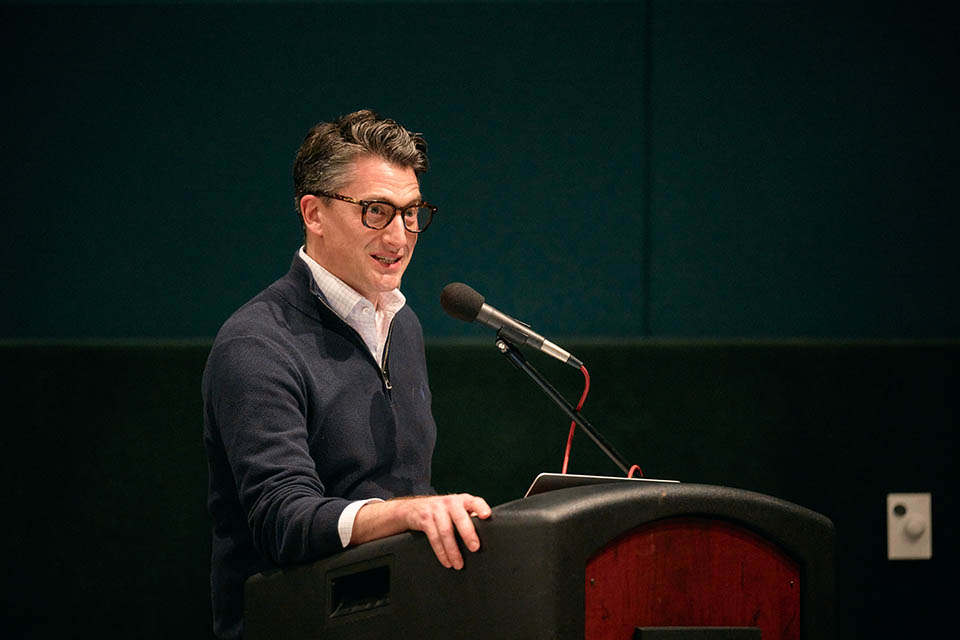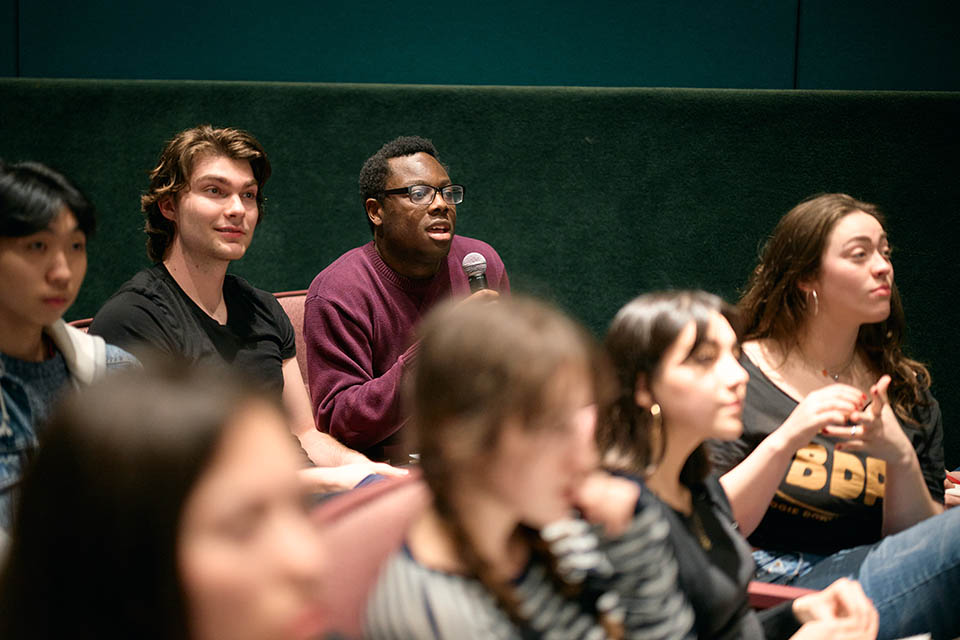Industry veteran Julie Taymor visits UNCSA to share life, work with students
“You have to get out of your own culture to see yourself and your culture in a clear way,” explains interdisciplinary artist Julie Taymor to a theater full of UNCSA students and faculty. “The travels of my life, being outside of myself and my comfort zone, influenced my art profoundly, and I think that is the best thing you can do as an artist because it will test what you think you know.”
Presented through a joint effort between the Thomas S. Kenan Institute for the Arts, the School of Dance and the School of Filmmaking, Taymor was invited to campus for three days in early February to speak with students about her life and work.
An American director and writer for film, theater and opera, Taymor has spent her life in the arts “playing with fire.” One of her most notable projects is adapting and directing the original stage production of “The Lion King,” for which she won Tony awards for Best Director and Best Costume Design.
Taymor has also directed several notable feature films, including the 2002 biographical film “Frida” starring Selma Hayak about Mexican surrealist artist Frida Khalo, the movie musical “Across the Universe” which utilizes the music of The Beatles, and the Shakespeare film adaptations “Titus” starring Sir Anthony Hopkins and “The Tempest” starring Dame Helen Mirren. Her opera directing credits include several iterations of “The Magic Flute,” which have been produced all over the world, “Grendel” by Elliot Goldenthal for the Los Angeles Opera and “Oedipus Rex” for the Saito Kinen Orchestra in Japan.

Julie Taymor's visit was presented through a joint effort by the Thomas S. Kenan Institute for the arts, the School of Dance and the School of Filmmaking. Pictured from left to right: Kevin Bitterman, executive director of the Kenan Institute, Dean of Filmmaking Deborah LaVine, Julie Taymor and Dean of Dance Endalyn T. Outlaw. / Photo: Wayne Reich
Dean of Dance Endalyn T. Outlaw worked closely with Dean of Filmmaking Deborah LaVine and Kevin Bitterman, executive director of the Thomas S. Kenan Institute for the Arts, to bring Taymor to campus to share her experiences with students, faculty and staff.
“I’m so glad to have been able to facilitate Julie’s visit to UNCSA in conjunction with an amazing team of people who worked to support and pull all the moving pieces together to bring her visit to fruition,” says Outlaw. “Julie exemplifies an interdisciplinary artist with a career that merges myriad artforms in seamless and reverential practice. That is why I felt it essential to get her in front of our students and our entire community as we continue to make space for cross-disciplinary work within our schools, through upcoming projects, and ultimately embedded in future curriculum.”
This team of campus leaders made it possible for Taymor to speak to the campus community about her career, tour the campus, learn more about the collaborative and inventive artistic process at UNCSA and visit classes to work more closely with students.
Dean LaVine says the overall visit invigorated her students in the School of Filmmaking and beyond. “Julie Taymor sparked students and faculty to challenge their preconceptions about artmaking, fame, and success,” explains LaVine, who joined UNCSA in 2021 after years of working at the California Institute of the Arts (CalArts). “Having interactions with an artist of Taymor's caliber pushes the UNCSA envelope artistically and professionally.”
Since his appointment as Executive Director of the Thomas S. Kenan Institute for the Arts at UNCSA in 2021, Kevin Bitterman has worked with each school to develop residencies and connectivity between UNCSA and creative industry leaders like Taymor. “The UNCSA campus provides an incredible opportunity for experimentation and incubation of new approaches to performance and storytelling,” explains Bitterman. “Julie Taymor’s residency not only activated the creativity of UNCSA students and faculty, but it also allowed us to feature the state-of-the-art facilities at UNCSA, including the Media and Emerging Technology Lab where Taymor led a workshop with students using movement, motion-capture and in-camera visual effects.”
In the days leading up to the visit, the School of Filmmaking organized daily screenings of a few of Taymor’s films, including “Frida,” “The Tempest,” “The Glorias” and “Titus” all of which were coordinated by the Moving Image Archives at UNCSA. After the visit University Librarian Sarah Falls curated a list of online options to view Taymor’s work for those that were unable to make the screenings. Taymor remarked that this was the first time she had spoken at an educational or arts organization where they had prepared the students so well, saying, “I am glad you have had the opportunities to actually see the work we will be discussing.”
During her visit, Taymor gave two separate 90-min demonstration lectures for students in a retrospective she calls “Essence and Spectacle.” Her first session focused on a cumulative view of her work and explored her role as a leading figure in film and the creator of iconic theatrical productions.
Taymor’s second session was a deep dive into four different projects from her career that focused on the transference of her creative work from stage to film, film to stage, and animation to theater.
Focusing on two different Shakespeare adaptations that she had directed for both stage and screen, “Titus” and “The Tempest,” Taymor dove into the process and differences between the two mediums. For “Titus,” Taymor told students that she chose to direct it as her first feature film because it is her favorite Shakespeare and it was the first play she had ever read that genuinely shocked her saying, “I felt compelled to explore what I consider to be the greatest dissertation on violence I had ever seen.”
Taymor also explored “The Tempest” through the same lens and explained how Dame Helen Mirren came to originate the gender-swapped version of the character Prospero, renamed Prospera for the film, saying, “Helen and I were lamenting that there were no good Shakespearean roles for older women and when I mentioned wanting to do ‘Tempest’ it was her idea to be Prospera.” Taymor then reworked the script and discovered that it ended up “fitting better” than the original.

Taymor speaking with faculty and students in the Ace Theater Complex. / Photo: Wayne Reich
When discussing “Across the Universe,” Taymor focused on the difficulty of creating a movie musical without the guide of a stage production to pull from, which is typically the norm. The film stars Evan Rachel Wood – a North Carolina native and daughter of School of Drama alumnus Ira David Wood III – Jim Sturgess and Joe Anderson as their characters move through the turbulence of the 1960s, including the Vietnam War. Taymor added that a lot from the time period was inspired by her own teen years.
Finally, Taymor rounded out the conversation with a deep dive into the creation of “The Lion King,” which she adapted from an 80-minute animated film to a two-hour stage production. Not only did Taymor rework the script but she also developed the iconic costumes, which utilized classic puppetry techniques to mimic the movement of the animals by the actors. This was a new challenge for Taymor, who was able to call on her training in sculpture and mask technique to bring the animals to life.
Taymor spoke about her lifelong commitment to conscientious storytelling and shared that, 'no matter how much she has been rewarded with commercial success, her boundless curiosity (and work ethic) continues to push her creativity.'
Dean of Filmmaking Deborah LaVine
This topic was particularly interesting to Dean Outlaw as she was an original cast member of the production and is how she first came to know Taymor. “Having worked with Julie as an original cast member of ‘The Lion King’ allowed me to witness an artist passionate, curious and confident enough in her creative vision to hold true to her interests and aspirations,” says Outlaw.
Throughout her presentations, Taymor talked about the impact that extensive international traveling – including four years of living in Indonesia – had on her creativity and overall mindset. This background was inspiration for the Taymor World Theater Fellowship which provides "travel opportunities for enterprising young theater directors to immerse themselves in artistic experiences beyond our borders."
LaVine believes that the visit will have a lasting impact on the campus, saying, “Taymor sparked students and faculty to challenge their preconceptions about artmaking, fame and success. Taymor spoke about her lifelong commitment to conscientious storytelling and shared that, “no matter how much she has been rewarded with commercial success, her boundless curiosity (and work ethic) continues to push her creativity.”
Agreeing with LaVine, Outlaw adds, “Julie’s time on campus was deeply inspiring as she candidly shared many of the personal and professional experiences that shaped her into the iconic and groundbreaking maker she is today.”
Julie Taymor’s visit was made possible by support from the Thomas S. Kenan Institute for the Arts.
Get the best news, performance and alumni stories from UNCSA.
SUBSCRIBE TO OUR NEWSLETTERS(OPENS IN NEW TAB)(OPENS IN NEW TAB)(OPENS IN NEW TAB)(OPENS IN NEW TAB)(OPENS IN NEW TAB)(OPENS IN NEW TAB)(OPENS IN NEW TAB)
March 16, 2023
